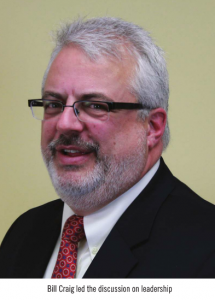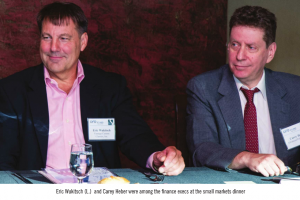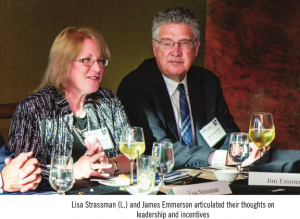As Seen in CFO Studio Magazine Q4 2015 Issue
 SUCCESSFUL LEADERS HAVE SUBSTANCE, INTEGRITY, AND VISION
SUCCESSFUL LEADERS HAVE SUBSTANCE, INTEGRITY, AND VISION
“To Lead, or Not to Lead,” that was the question, during a CFO Studio Small Markets and Emerging Growth Companies Executive Dinner, held recently at Red Knot at Galloping Hill in Kenilworth, NJ. Bill Craig, Chief Executive and CFO of Tarantin Industries, a wholesale distributor of propane equipment, heaters, and hearth products, was discussion leader, and Andrew Zezas, Publisher of CFO Studio magazine, and Host of CFO Studio, facilitated the conversation.
Mr. Craig’s perspective is an interesting one as he is both a CEO and CFO at Tarantin Industries. “As a CEO, your foot’s on the gas; as CFO, it’s on the brakes,” said Mr. Craig. “The challenge has been to try and balance those two things in terms of motivating people. Everyone wants to do well. They want to be appreciated. They want to be taught. They want to be led. Leading is about resolving uncertainty. … As the CFO, you’re the risk manager. …As a CEO, you’re leading the way.”
Leadership for CFOs at middle-market companies presents added challenges, as the CEO is setting the agenda, but, said Mr. Craig, “You’ve got to figure out how to lead and also do your job.”
The 22 CFOs in attendance offered their tried-and-true strategies for becoming successful leaders, with a few rejecting the premise that certain people are born leaders and others are not. What successful leaders have in common, the group agreed, is substance, integrity, and a vision — not just style and image. Leaders establish connected relationships and inspire colleagues. They bring teams together around a shared purpose and a common set of values. When you look at great leaders, whether in the military or in business, they are willing to put themselves at risk, if necessary, and to lead by example.
Effective leaders are transparent. “I start my day by saying good morning to everybody. That’s important because it’s my opportunity to say, ‘How’s it going? What do you have to do today? Any problems that you had yesterday? Do we need to talk about anything?’ It’s my first chance to interact with everyone. I lead with communication,” said Ron Tassello, CFO of Bardwil Industries, based in Hasbrouck Heights, NJ, a textile manufacturer of fine kitchen and bath products and linens.
Leadership is not static; it is constantly evolving. “I’m required to demonstrate multiple types of leadership, because if I’m dealing with the factory workers and managers, they need one type of leadership. When I deal with IT, they require a different type of leadership,” said Eric Wukitsch, COO and CFO, Vantage Custom Classics, an Avenel, NJ–based manufacturer of identity apparel.
A common challenge is dealing with business owners, the attendees agreed. When leading a group where one has established authority, those whom you lead are compliant to a certain extent. Leading a leader creates a different set of challenges. “I don’t think anybody in this room will dispute that there are times when ownership has grandiose plans and we have to bring them back to reality,” said Mr. Wukitsch. It’s important to know when to push and when to back off, when to lead and when to serve.
“You’ve got to get them on the same wavelength, then you can lead. That is so important,” said Ed Schultz, Principal of Allendale, NJ–based Highland Business Group, a consulting firm.
Born to Lead
“Is one born with the capacity to lead or is it an acquired skill?” a question that has been debated for decades, became an important component of the conversation during this CFO Studio Executive Dinner.
“You are either born with it, or you’re not. If you don’t have it, you can develop it a bit, but you’re never going to be an effective leader,” said Walter Cirillo, Vice President, Treasurer of Edison, NJ–based AeroGroup International, which designs, imports, and distributes Aerosoles footwear. “Leadership traits are not learned in school. You are born with the ability to know when and how to get in front to rally your troops to victory,” added Robert Berkowitz, CFO of Pine Brook, NJ–based Wilmington Paper Corporation, specializing in recycling-management programs.
Creating an environment of empowerment is one of the ways successful leaders lead. Employees know they are being heard and respected and that the organization values their contributions.
Dancker, Sellew & Douglas (DS&D), a Somerville, NJ–based interior solutions firm, has been in business for more than 180 years. In 2012, the current CEO became the majority owner of the company and implemented a six-person leadership team from all different backgrounds with varied skill sets, said William Hendry, DS&D’s CFO. In order to ensure the leadership team is working as a cohesive unit, company leaders participate in leadership training every Wednesday for two hours and during two off-site events held every spring and fall.
“As an executive team, we’re really focusing on the customers first. Then, we are focusing on our employees — empowering them…” said Mr. Hendry. “We do whatever we can to build morale and inspire employees to enjoy coming to work and pulling together to do a better job for our customers.”
Employees who are engaged and feel good about the environment in which they work will be more productive. It’s important to remember that when it comes to employee engagement, a one-size-fits-all mindset can be an ineffective approach. “I have lived in many countries, and have learned that what worked in one part of the world would not necessarily work in another. For example, in Chile you have to be a very formal leader, because even the doorman wears a suit in the summer. In Puerto Rico, I would take my people to a bar for drinks some Friday evenings to build camaraderie and to get them engaged with each other,” said Javier Daly, CFO, TerraCycle, a Trenton, NJ–based recycler of post-consumer waste.
A successful leader is authentic, genuine, and recognizes the motivations of those he or she leads.
“Understanding the culture of an organization, either as it exists or as it should become, and then making sure that the style of leadership coincides with that culture, is essential,” said Mr. Zezas.
Genuineness and authenticity are important traits of a great leader, agreed Tobey Rumack, CFO, Universal Marine Medical Supply International, a Staten Island, NY–based maritime industry supplier. “One can be a great communicator, but if that person is not genuine, their followers will eventually become disenchanted. When there is not trust, followers will not go the extra mile,” said Ms. Rumack.
Visionaries
Another hallmark of successful leaders is that they have a clear and concise vision and are able to commun icate that vision. “People will respond better if they understand why you’re changing what you’re changing, why you’re going where you’re going, and what the vision is,” said Eileen Black, Controller, Stevens Institute of Technology, in Hoboken, NJ. “A successful leader will lay out ‘Here’s why we’re taking this approach and heading in this direction. And then, it goes even deeper than that,” she added. “We’re the bridge between that vision and employees. Great leaders help their people overcome barriers that may stand in the way of achieving the objectives and succeeding.”
icate that vision. “People will respond better if they understand why you’re changing what you’re changing, why you’re going where you’re going, and what the vision is,” said Eileen Black, Controller, Stevens Institute of Technology, in Hoboken, NJ. “A successful leader will lay out ‘Here’s why we’re taking this approach and heading in this direction. And then, it goes even deeper than that,” she added. “We’re the bridge between that vision and employees. Great leaders help their people overcome barriers that may stand in the way of achieving the objectives and succeeding.”
Discussion leader Bill Craig pointed out the nuances of leading in an institution like Stevens, versus a public company. “When I led a public-company turnaround, it was easy, because everybody saw the numbers and knew every quarter what we were doing. When you’re a leader, and specifically a CFO, in a private company, often ownership prefers not to share sensitive information, so it’s really important to be articulate and communicate well to get the buy-in.”
Gift cards, cash, merchandise, and travel as incentives are effective business tools that promote or encourage specific actions. Successful leaders understand the power of incentives; James Emmerson, CFO, Oradell, NJ–based Huntington Learning Corporation, is one of them. “Our company is privately owned. So, the only people who see an entire P&L are the owners, my controller, and me. Basically, we give each department its own P&L, and we incentivize them to achieve predetermined results. I learned a long time ago that if you incentivize somebody to do something important, that is what they will focus on.”
Timothy O’Donnell, CFO of The Falk Group, a New York City–based marketing agency, also recognizes the importance of incentives. “One of the things that I found to be successful is when you create goals and incentives for employees, they have more of a buy-in. It’s also important to remove any barriers that may exist that may prevent them from reaching their goals.”
Leaders and Empathy
It has been proven that empathy goes a long way toward encouraging employees to perform at their best. “I care deeply about all the people that I oversee, and they know it. It’s genuine. I get to know the employees and get to know what makes them tick, and if they need to cut out at four o’clock, they know they can do so. I don’t overstep the employer/employee relationship, but they know I care,” said Darrin Shamosh, CFO of Newark, NJ–based Interport, a company that sells and rents intermodal shipping containers. “The other thing I have found to be successful is to give people some rope. Let them make a mistake. It’s okay, if … you don’t make the same mistake twice.”
Improving their own listening skills, decreasing conflict, and controlling impulsive reactions help leaders develop. These traits are often referred to as emotional intelligence. “There are three legs to success. One is your IQ that you are born with. Second is your acquired knowledge. The third leg is the one that I find so many people overlook. It’s probably the most important one — emotional intelligence — the ability to relate with people,” said Howard Reba, Finance Operations Group Director of California-based Marlin Equity Partners, a global investment firm.
Empathy is used day in and day out by Lisa Strassman, Director of Finance, CAO, for Orangeburg, NY–based Daikin America, which develops, manufactures, and sells fluoropolymers, fluoroelastomers, fluorochemicals, and fluorocoatings. “I focus on understanding the varying perspectives of all involved in a situation. I get in there and I figure out what really stresses them out, and work with them to improve their day-to-day life,” said Ms. Strassman. “I show them that management does care, that we do get it, that we can help them, and that we can improve technology. … I think that they respect me as their leader because I understand them and know what they’re doing.”
Mr. Craig asked Ms. Strassman if there has ever been a time when an employee took advantage of her help. “I make sure that they don’t use me as their assistant. I challenge them.…I don’t give them the answers all the time,” said Ms. Strassman. “There are folks in leadership positions who don’t agree with my methodology because they think I may be too much in the trenches. What they don’t understand is that I’m building team morale and I’m helping the day-to-day process, and I’m also working to prevent employees from quitting.”
“Your comment about leaders not being assistants is a brilliant statement,” said Mr. Zezas. “I see new leaders very often taking on too much responsibility, because they figure, ‘I’m going to do all the work.’ Leadership and doing all the work are two very different things that, with the right balance, have to come together.”
Ms. Strassman concurred. “I’ll take every criticism from the executive leader saying that I’m too much involved. I’ll take that any day over being so far removed that the team doesn’t appreciate me, doesn’t respect me or what I know. I need to be there for them. That’s how I lead.”
Rob Guerrera, Senior Vice President and CFO, Kline & Company, a Parsippany, NJ– based consulting company, joined in. “Lisa, what really resonates with me about your comment is that leadership grows; it needs to be opportunistic, yet you need the inherent skills and the comfort level of putting yourself out there and taking advantage of the opportunities. We need to do what Rudy Giuliani did and find what is easy to fix. Fixing the squeegee problem that existed on Manhattan’s streets is what he decided was his first order of business as mayor, and he built a path of success. The hard jobs become easier when the little jobs are taken care of.”
Not only are empathy and emotional intelligence important, but so is trust. You can have a clear-cut vision, an ironclad strategy, and successful communication skills. But if the team doesn’t trust you, you will not be effective. “When you build a relationship, that person will go the extra mile for you,” said Fred Guerra, Vice President, Finance of Rockleigh, NJ–based Takasago International Corporation, a flavor and fragrance company.
 Talent Development
Talent Development
Employers are gearing up for millennials, a generation that is not afraid to move from one job to the next. “My dad worked 40 years in the same place. Our kids will be far different,” said Michael Roth, CFO, Beefeaters Holding Company, a North Bergen, NJ–based manufacturer of dog treats.
An effective leader must understand not just the millennial generation, but all those he or she leads. Glenn Turell, CFO of New York City–based Elias Arts Holdings, a music, sound, and audio branding collective, said, “My company is private equity–owned. We have two subsidiaries and two Boards of Directors. But we are a company made up of creative types who don’t necessarily respond to business communications, especially if coming from someone not seen as a creative. The way I communicate with the Boards and senior management has to be very different than the way I communicate with the company’s creatives, especially those who are more junior. In certain cases, I’ll look to our head of operations, who is also the executive creative director, to drive home certain specific business points that I know will not get through to the creative staff if seen as coming directly from me or the Boards.”
Some have perfected their leadership skills by being exposed to ineffective leaders. “When I was coming up in the ranks, there were times when I wasn’t treated well by some leaders, and I think that impacted me to be respectful of people. When you’re respectful, you’re going to get more out of people than by pounding a hammer,” said Carey Heber, CFO of Carlstadt, NJ– based Advanced Polymer, a specialty chemical company.
Mr. Craig had a similar experience. “I learned what to do by learning what not to do,” he said.
“What this is all about is creating a culture within an organization that allows and promotes cream to rise to the top, for lack of a better analogy. You are allowing employees to become leaders.
…You are allowing them to blossom,” said Mr. Guerra.
Good leaders make the tough decisions that need to be made. “They say, for the greater good, this person needed to go,” said Mr. Tassello.
The most successful leaders are authentic, the group agreed, they are self-aware and genuine and mission-driven and focused on results. They lead with their heart, not just their minds, with substance, integrity, and a vision — not just style and image. Some are born, some are made. They establish connected relationships and inspire colleagues. They bring teams together around a shared purpose and a common set of values. They lead by example.



